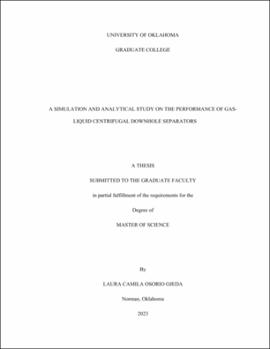| dc.description.abstract | A common issue in depleted oil and gas wells is the lack of energy to drive the fluids to the surface. Engineers use various artificial lift systems to solve this problem, most commonly by using pumps. Many pump types do not perform at their maximum capacity when working in the presence of gas. To address this problem, downhole separators can be used. This study seeks to understand the dynamics of the fluid flow inside one of the common types of such separators, static downhole centrifugal type. The study compiles an extensive literature review of gas-liquid centrifugal separation.
Data are collected from the literature review to feed a machine learning model and predict the equipment’s efficiency. A total of 272 data points are extracted from the literature. These data are used to perform dimensional analysis and obtain dimensionless numbers to feed five machine learning algorithms: linear regression, random forest, K-nearest neighbor, support vector machine, and voting. The data are used to determine the best model in predicting separation efficiency. The voting algorithm is the best predictor for this dataset. It has a cross-validated adjusted R2 of 0.535 and RMSE of 0.138 on the set. This means that the predictor can represent 53.5% of the variance in gas separation efficiency data with an error of 13.8%.
Single-phase and multiphase study cases are run of the fluid domain of a static centrifugal separator using ANSYS Fluent 2023. Realizable k-epsilon turbulence and multiphase Eulerian models are used for the conducted simulations with pressure and mass-flow rate boundary conditions. Pressure, velocity, and volume fraction contours, and outlet velocity profiles are analyzed for each case.
From the single-phase cases, it is observed that the velocity of the fluids increases about five times in the outermost section of the helix-type path of the separator. In all the cases, the fluids leave the domain through the top outlet, which has the biggest cross-sectional area. Eddies or vortexes are formed in certain cornering sections of the equipment. Future re-designs can be performed to minimize these eddies. Additionally, eddies in the separator's upper section are caused by the high velocity at which the fluids are expelled from the helical section to the annulus.
The gas-liquid flow was studied inside the helix-type paths through the multiphase study cases. The totality of the liquid was expelled through the bottom outlet. Furthermore, from these cases, it was verified the importance of having a higher pressure at the bottom outlet for the correct convergence of the study cases. Through analysis of the velocity profiles in the outlets, it can be seen how the air tends to leave the domain through the top outlet, while the water through the bottom outlet. It was observed that pressure control influences the separator performance, when the bottom outlet pressure is set as 1500 Pa higher than the top outlet pressure, the water leaving the domain through the bottom outlet is 98.3% and the air leaving through the top outlet is 85%. | en_US |

